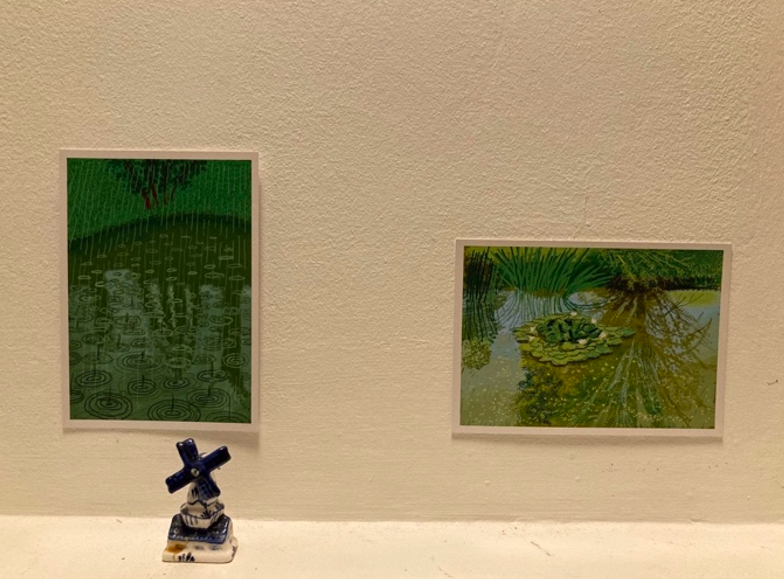I’m sure we all remember Spring of 2020 to be an idyllic time. Although, certainly, no-one enjoyed it more than David Hockney, who spent it in his beautiful countryside residence in Normandy and recorded its arrival on his iPad. His ‘iPad paintings’, as he calls them, were exhibited at the RA this year. The exhibition was a thorough record of the passage of the 2020 Spring in Normandy, with a helpful visual aid of each cloud, pond and grass that crossed Hockney’s path. I was not actually going to see this exhibition until recently when in September, the ground a sludge of dead leaves and wet slugs, off I went to celebrate the Arrival of Spring.
The exhibition had not been met with sparkling reviews; critics were underwhelmed by the digital medium. ‘There’s an ugliness in the digital marks,’ said Ben Luke of The Evening Standard; Alistair Sooke reported that there was ‘little sign of human life’. So, I envisioned breezing through it, complaining, then heading off to the RA cafe for the Arrival of a Jam Tart. Sadly, though, there was a fatal flaw in my plan: David Hockney has been painting and drawing for 60 years and as a result his work is full of skill. The pictures were quite enjoyable, and I was particularly fond of his ponds. All in all, it demanded more than the absent breeze.

But I certainly didn’t think it was good. Hockney is very much pleased with himself, or he is indulging himself, and it means that there was no critical eye applied to the work in the exhibition – it seems everything he produced happily cruised on in. Although there is so much work squashed in, there is no sense at all that Hockney is investigating a particular subject (probably because he couldn’t create detail or intensity on the iPad) so the exhibition felt static. To solve this problem, because there really does need to be some sort of artistic evolution to justify an exhibition, the lack of progression is replaced with a painfully explicit reminder of the passing of time – now it is day, now it is night, now this tree has a few more leaves on it. There was no curation of this exhibition at all, because Hockney and his curators think that whatever he produces will be revered. (I might add here that the RA website advertised that because the pictures had been enlarged, a viewer could admire ‘every mark and stroke of the artist’s hand.’)
What does it say about digital art if Britain’s most influential, most marvellous and quite frankly most Godlike painter can cram a painting with artistic ability and the result is forgettable? Hockney has been digital painting for over ten years, and before that he was making portraits using a polaroid camera. He has always been eager to jump on new technology, but he does not embrace it as a separate artistic medium. He obviously doesn’t, because why is it in an exhibition? Art is exhibited because it cannot appear in two places at one time – it has to travel, and age. It has an unmistakable materiality that makes it quite thrilling, but in the case of digital art I don’t see what’s wrong with a handy email, or a presentation on Google Slides.
Hockney likes to use the iPad because he regards it to be an easier way to paint. You don’t have to lug your equipment across ten fields, you can paint in the dark, or on the way to the loo as he tells us in the exhibition catalogue. David Hockney is a painter who knows he has produced his legacy and sees no need now to slug along ten fields. It is noteworthy that Hockney probably would not have produced so much work, and such large pieces, if it were not for his most dearly loved iPad. But iPad painting is feeble and unengaging compared to the excitement of sculpture, the refinement of drawing, or the seduction of paint.
I had not seen any of Hockney’s work in the flesh since The Bigger Picture in 2012, when I went in a Cinderella dress and got lost so I really don’t think it counts. Hence, I am open to a change of heart, but currently my view of Hockney is that his work looks like a hollow show of skill. When it is very good it shows David Hockney’s skilfulness, but if great paintings are like Medusas, capturing a viewer and freezing them, then Hockney’s portraits are like gazing into the friendly eyes of a happy horse as you feed him carrots for his lunch. If Hockney’s work is generally skilful but hollow, then maybe he doesn’t see why digital art, hollow but skilful, would be any different from painting. But I do think digital art is very different. Advanced technology means that an iPad can offer a number of colours and lines, but the possibilities of an artist’s hand are infinite; Hockney claimed that he was aiming to recreate the endless detail and interest of the natural world, but on his iPad, he must settle for crudely simplistic representations. But I suppose on the bright side it means we won’t suffer the indulgence of a seventy-room exhibition again, as Hockney will soon move onto his next quest.

So, my final thoughts: the pictures fit snugly onto a postcard or calendar, the exhibition was prepared for school trips (I inferred from the gift shop bowls of bouncy eggs) and both Hockney and his lovely iPad paintings are cheerful and untroubled. Maddening but probably for the best because Hockney is eighty-four and does not have long to spend going through tiresome stages of trembly moments and confidence building. Although if he does decide to read some reviews, the ease of the iPad might aid him in carving out some time.
